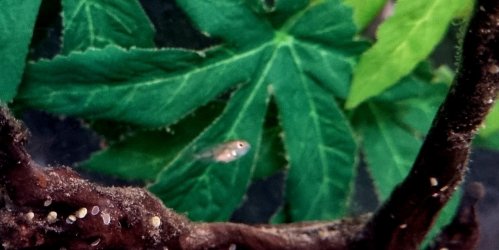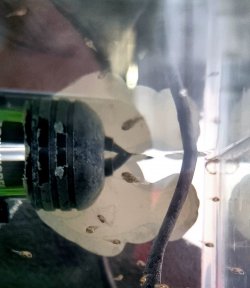Taken from the following link.

 www.fishforums.net
www.fishforums.net
If you buy brineshrimp eggs online, check the prices of a big container of eggs and compare it to small containers. Keep the eggs in the fridge/ freezer in an airtight container so they last longer. Small containers cost more. Obviously if you are not sure about whether you want to use them, try a small container first and see how it goes.
BRINESHRIMP
Brine shrimp eggs are readily available from pet shops and can be hatched out in salt water to provide a valuable source of food for young fish. Most nutritional value from brine shrimp is obtained during the first two days after hatching while they still have their yolk sac.
Dry brineshrimp eggs should be kept dry and in an air tight container in the fridge or freezer to maximise their shelf life.
A simply brineshrimp hatchery can be made out of a 2 litre plastic drink bottle. Cut the top off the bottle and throw the top bit away. Half fill the bottle with sea water or salt water made to the same salinity as sea water. You can buy a hydrometer from any pet shop to measure salinity in water. You can use rock salt, sea salt, or swimming pool salt for this. Put an airstone in the container and add 1/4 of a level teaspoon of dry brineshrimp eggs to the salt water. Put the container somewhere warm, I had mine on top of an aquarium. The eggs are brown and take 24-48 hours to hatch, depending on temperature. In warmer water (28-30C) they hatch faster than in cooler water (20C). When you see orange dots in the water, the eggs have hatched. The orange dots are the baby brineshrimp called nauplii.
Plastic multi coloured airstones are the best airstones to use because they can be taken apart and the salt and old egg shells can be removed. Many brands of these airstones also have a small lead weight in the bottom that helps hold the airstone at the bottom of the container.
To harvest the baby brineshrimp, you remove the airstone, wait 5 minutes for the eggs and nauplii to separate, and then use an eye dropper to suck the nauplii out and feed them to the fish. The nauplii are attracted to light, so having a light on one side of the culture will encourage the baby shrimp to gather in one spot and makes them easier to syphon out.
Try not to put the brown eggs into the rearing tanks because fry can choke on them.
A plastic plant mister can be filled with freshwater and used to wash the salt and eggs off the sides of the hatchery throughout the day.
After you have fed the nauplii to the fish fry, put the airstone back in the culture and wait until the fry need feeding again before removing the airstone and sucking out more nauplii.
A couple of days after the eggs have hatched the culture will start to go off due to the egg shells rotting in the water. When this happens you tip out the remaining culture onto the garden and wash the container and airstone/ airline and make them nice and clean. Then you can re-use the container to start a new culture.
You should start a new culture every day or every second day and use up all the nauplii within 48 hours of the eggs hatching because that is when they have the most nutritional value. You can feed surplus nauplii to adult guppies, dwarf gouramis, tetras, barbs, rainbowfish, virtually any fish less than 5 inches long will eat newly hatched brineshrimp.
DECAPSULATED BRINESHRIMP EGGS
You can get decapsulated brineshrimp eggs and these don’t rot in the water. Decapsulated eggs have had the shell removed and you can either hatch them out normally in salt water, or feed the eggs directly to the fish.
If you want to decapuslate your own brineshrimp eggs you can do it quite easily. You add some dry eggs to a bottle or container of fresh water, and add some bleach or granular chlorine. You swirl this solution around until the brown eggs go orange. The bleach dissolves the brown egg shell leaving behind the orange egg. At which point you gently pour the orange eggs into a fine mesh net and rinse under some tap water. After a few minutes rinsing you put them in a container of freshwater and add a double dose of dechlorinator and swirl around for a couple more minutes. Then one more rinse under the tap before adding the eggs to some salt water to hatch.
This takes a bit of practice and if you leave the eggs in bleach for too long you kill them. If you don't leave the eggs in the bleach for long enough you have white egg shells in the hatching container.
You can use different concentrations of bleach and find one that works for you. Stronger bleach solutions will dissolve the egg shell faster so you have to watch the eggs for the changing colour.

Back to Basics when Breeding Fish
STARTING OUT Make sure you have a pair, (1 male + 1 female). There is nothing worse than spending your hard-earned dollars buying a couple of fish to try and breed and ending up with a pair of fish of the same sex. Let's face it, to reproduce fish you need a male and a female. Two males won't do...
 www.fishforums.net
www.fishforums.net
If you buy brineshrimp eggs online, check the prices of a big container of eggs and compare it to small containers. Keep the eggs in the fridge/ freezer in an airtight container so they last longer. Small containers cost more. Obviously if you are not sure about whether you want to use them, try a small container first and see how it goes.
BRINESHRIMP
Brine shrimp eggs are readily available from pet shops and can be hatched out in salt water to provide a valuable source of food for young fish. Most nutritional value from brine shrimp is obtained during the first two days after hatching while they still have their yolk sac.
Dry brineshrimp eggs should be kept dry and in an air tight container in the fridge or freezer to maximise their shelf life.
A simply brineshrimp hatchery can be made out of a 2 litre plastic drink bottle. Cut the top off the bottle and throw the top bit away. Half fill the bottle with sea water or salt water made to the same salinity as sea water. You can buy a hydrometer from any pet shop to measure salinity in water. You can use rock salt, sea salt, or swimming pool salt for this. Put an airstone in the container and add 1/4 of a level teaspoon of dry brineshrimp eggs to the salt water. Put the container somewhere warm, I had mine on top of an aquarium. The eggs are brown and take 24-48 hours to hatch, depending on temperature. In warmer water (28-30C) they hatch faster than in cooler water (20C). When you see orange dots in the water, the eggs have hatched. The orange dots are the baby brineshrimp called nauplii.
Plastic multi coloured airstones are the best airstones to use because they can be taken apart and the salt and old egg shells can be removed. Many brands of these airstones also have a small lead weight in the bottom that helps hold the airstone at the bottom of the container.
To harvest the baby brineshrimp, you remove the airstone, wait 5 minutes for the eggs and nauplii to separate, and then use an eye dropper to suck the nauplii out and feed them to the fish. The nauplii are attracted to light, so having a light on one side of the culture will encourage the baby shrimp to gather in one spot and makes them easier to syphon out.
Try not to put the brown eggs into the rearing tanks because fry can choke on them.
A plastic plant mister can be filled with freshwater and used to wash the salt and eggs off the sides of the hatchery throughout the day.
After you have fed the nauplii to the fish fry, put the airstone back in the culture and wait until the fry need feeding again before removing the airstone and sucking out more nauplii.
A couple of days after the eggs have hatched the culture will start to go off due to the egg shells rotting in the water. When this happens you tip out the remaining culture onto the garden and wash the container and airstone/ airline and make them nice and clean. Then you can re-use the container to start a new culture.
You should start a new culture every day or every second day and use up all the nauplii within 48 hours of the eggs hatching because that is when they have the most nutritional value. You can feed surplus nauplii to adult guppies, dwarf gouramis, tetras, barbs, rainbowfish, virtually any fish less than 5 inches long will eat newly hatched brineshrimp.
DECAPSULATED BRINESHRIMP EGGS
You can get decapsulated brineshrimp eggs and these don’t rot in the water. Decapsulated eggs have had the shell removed and you can either hatch them out normally in salt water, or feed the eggs directly to the fish.
If you want to decapuslate your own brineshrimp eggs you can do it quite easily. You add some dry eggs to a bottle or container of fresh water, and add some bleach or granular chlorine. You swirl this solution around until the brown eggs go orange. The bleach dissolves the brown egg shell leaving behind the orange egg. At which point you gently pour the orange eggs into a fine mesh net and rinse under some tap water. After a few minutes rinsing you put them in a container of freshwater and add a double dose of dechlorinator and swirl around for a couple more minutes. Then one more rinse under the tap before adding the eggs to some salt water to hatch.
This takes a bit of practice and if you leave the eggs in bleach for too long you kill them. If you don't leave the eggs in the bleach for long enough you have white egg shells in the hatching container.
You can use different concentrations of bleach and find one that works for you. Stronger bleach solutions will dissolve the egg shell faster so you have to watch the eggs for the changing colour.



 and still looking like tadpoles lol
and still looking like tadpoles lol
